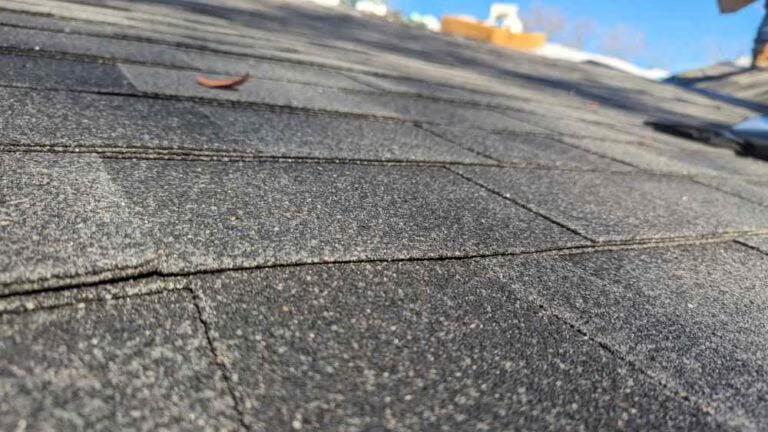Yes, roofing nails can indeed be too long. When nails exceed the necessary length, they risk penetrating too deeply, potentially compromising the roof's structural integrity by piercing through the decking. This miscalculation not only affects stability but also increases the possibility of leaks and decreases the overall durability of the roofing system. Correct nail length should be carefully chosen based on the type and thickness of roofing materials used, generally ensuring at least 3/4 inch penetration into the decking. Knowing the precise specifications for ideal nail length can greatly enhance the performance and lifespan of your roof. Discover more on ensuring robust roofing installations.
Key Takeaways
- Overly long nails can puncture underlying roof decking, compromising structural integrity.
- Excess length may lead to nails piercing the moisture barrier, increasing the risk of leaks and moisture damage.
- Long nails can reduce the grip strength, undermining the roof's resistance to wind uplift and other forces.
- Correct nail length is crucial for ensuring shingles and sheathing are securely fastened without causing damage.
- Using nails that are too long can violate local building codes and manufacturer installation guidelines.
Importance of Nail Length
Selecting the appropriate nail length is crucial for guaranteeing the structural integrity and longevity of a roofing installation. The choice of nail length must be guided by both the material thickness and the type of sheathing used. This precision prevents the peril of shingle blow-off or sheathing penetration failure, which can compromise the roof's efficiency and safety.
Nail compatibility is a critical consideration; the correct nail length assures that the nail penetrates the decking adequately but does not protrude excessively, which could damage underlying materials or decrease insulation effectiveness. Typically, a nail should penetrate at least 3/4 inch into the decking. For instance, when using thicker roofing materials, such as high-profile shingles or wooden shakes, longer nails are necessary to achieve adequate anchorage.
Installation techniques also play a pivotal role. Proper angling and depth setting of nails during installation prevent the lifting of the nail head over time, a common issue that can lead to leaks and material wear. Using a nail gun, make sure it is adjusted to the correct depth setting to match the nail length and roofing material. This technical approach not only secures the roof effectively but also upholds the freedom of worry from future structural concerns.
Roofing Nail Basics
Roofing nail basics begin with understanding the important role of nail length in securing materials properly without causing damage. The right length guarantees adequate penetration into the roofing substrate while preventing the risk of piercing through and compromising the structure. Selecting the appropriate nail length is essential to maintaining the integrity of the roof and avoiding unnecessary material strain.
Nail Length Importance
The appropriate length of nails is essential in securing a durable roofing installation. Selecting the right nail length is not just a technical decision but a commitment to the integrity and longevity of the roof itself. The choice of nail length should be guided by the type of roofing material used, the thickness of the roofing layers, and the environmental conditions the roof will face.
Using nails that are too short can lead to poor fastening and increased vulnerability to wind uplift, while nails that are too long can cause damage to the underlying structures or protrude in undesirable ways, compromising the roof's functionality. Nail gauge and fastening methods are critical factors in this decision. The gauge of the nail affects its diameter and holding strength, while the fastening method guarantees the nails are driven consistently and properly.
| Emotion | Impact on Roofing |
|---|---|
| Security | Ensures sturdy attachment |
| Peace of Mind | No concerns about roof failures |
| Pride | High-quality, professional craftsmanship |
Choosing the correct nail length is an expression of freedom — the freedom to tailor solutions to specific needs, securing not just functionality but also peace of mind and pride in one's workmanship.
Material Penetration Risks
Using nails that are overly lengthy can pose a risk of puncturing underlying materials, potentially leading to leaks and structural harm. When choosing the suitable length of roofing nails, one must take into account not only the thickness of the roofing material but also the potential for harming the roof deck or other crucial components beneath the shingles or tiles. Improper nail length may jeopardize roofing safety and the efficiency of installation methods, resulting in expensive repairs and potentially unsafe conditions.
To avoid such issues, consider the following points:
- Correct Nail Length: Select nails that penetrate the roof deck by at least 3/4 inch but not excessively long to penetrate through the entire deck.
- Check Local Building Codes: Adhere to local regulations that specify nail lengths and types for various roofing materials and styles.
- Professional Evaluation: Have a professional evaluate the multi-layer structure of the roof to suggest the best nail length for secure installation without excessive penetration.
- Routine Inspections: Post-installation checks should be carried out to confirm nails are appropriately positioned and have not caused unintended damage.
Risks of Overlong Nails
Employing excessively lengthy nails during roof installation can compromise the structural integrity of the roof deck and lead to potential damage. When nails exceed the necessary length, they can pierce through the decking material, reducing the overall grip and effectiveness of the nail. This misalignment not only undermines the structural integrity but also poses significant installation risks. Overlong nails can fail to secure roofing materials adequately, making them vulnerable to wind uplift and other environmental stresses.
Furthermore, the choice of nail length must be in line with nail compatibility and roofing safety standards. Using inappropriate nail lengths can introduce a host of problems, from decreased holding power to increased potential for leaks. Each type of roofing material requires specific nail lengths to ensure best installation and durability. Ignoring these requirements can lead to premature roof failure and unnecessary repair costs.
Professionals in the roofing industry must carefully select nail lengths that match the materials used and the environmental conditions expected. This attention to detail ensures the longevity and safety of the roofing structure, safeguarding the property and its occupants against the hazards of improper installation.
Structural Stability Concerns
When selecting roofing nails, it is important to think about how the length can impact structural stability. Overly long nails may compromise load distribution, potentially leading to increased shear risk which undermines the roof's integrity. Additionally, proper penetration depth must be maintained to guarantee that the nails effectively anchor the roofing materials without causing damage.
Compromised Load Distribution
Although often overlooked, overly extended roofing nails can contribute to compromised load distribution, potentially undermining the structural stability of the roof. When nails that are too long are used, they may penetrate deeper structural elements or protrude through the underlying layers, leading to a series of issues directly affecting the roof's load-bearing capabilities. This improper fastening not only disrupts the uniform spread of loads across the roofing system but also threatens the overall structural integrity of the building.
Key points to keep in mind are:
- Localized Stress Points: Extended nails can create stress concentrations at certain points, rather than distributing the weight evenly across the roof deck.
- Altered Nail Withdrawal Resistance: Excessive length can affect the grip of the nail in the decking material, potentially reducing the withdrawal resistance necessary for structural stability.
- Impact on Thermal Movement: Overly extended nails might interfere with the natural expansion and contraction of roofing materials, leading to structural distortions.
- Risk of Penetration Damage: There is an increased risk of damaging underlying roofing layers or structures, which can compromise their ability to support loads effectively.
Understanding these risks is essential for maintaining the safety and longevity of roofing structures, ensuring that every component functions at its best within the intended design parameters.
Increased Shear Risk
Excessive nail length can also escalate the risk of shear failure in roofing structures, compromising their overall stability. When nails that are too long are used, they may extend beyond the sheathing and fail to secure the roofing material properly. This inadequate fixation reduces the shear resistance of the roof, which is vital to withstand lateral forces such as wind or seismic activity.
To address this, proper installation techniques are essential. Roofing professionals must select nails that are appropriate not only in length but also in type and diameter, tailored to the material and structural requirements of the specific roof. For instance, shorter, thicker nails might be favored to enhance shear resistance in areas prone to high winds or earthquakes.
Moreover, the technique of nailing plays a pivotal role. Nails should be driven straight and flush with the roofing material to maximize contact and grip, which directly influences the roof's ability to resist shearing forces. Overdriving or angling nails can severely diminish their holding power and, by extension, the structural integrity of the entire roofing assembly, making meticulousness in installation paramount to ensuring long-term stability and safety.
Penetration Depth Limitations
Proper consideration of penetration depth is crucial, as nails that penetrate too deeply can compromise the structural stability of the roof. When selecting nails for roofing, their length must not only secure the shingles effectively but also respect the integrity of the underlying materials. Excessive nail depth can lead to several structural issues, making the choice of nail length a critical aspect in roofing projects.
Key Considerations for Penetration Depth:
- Avoid Over-Penetration: Guarantee the nail does not pierce through the roof deck, which could impair its strength.
- Material Compatibility: Select nail length based on the combined thickness of roofing materials to prevent unintended damage to underlying structures.
- Local Building Codes: Adhere to regional regulations that specify maximum penetration depths to maintain structural compliance and safety.
- Seasonal Adjustments: Consider seasonal variations in material expansion and contraction which might influence the optimal nail depth.
Moisture Damage Risks
Using overly long roofing nails can inadvertently puncture the protective moisture barrier, leading to potential water damage and associated risks. This scenario emphasizes the importance of precise nail selection and installation techniques as essential components of moisture prevention. When the barrier is compromised, moisture can seep into the roofing system, initiating a cascade of structural deteriorations, such as rot and mold. These outcomes not only threaten the integrity of the roof but also the overall health of the building environment.
The choice of nail length must be aligned with shingle durability; long nails can go through the shingle, undermining their ability to shield against water ingress. This delicate balance between nail length and effective shingle installation is vital.
To elucidate, consider the following table which details typical outcomes of using inappropriate nail lengths:
| Outcome | Short-Term Impact | Long-Term Consequence |
|---|---|---|
| Moisture Entry | Immediate leaks | Structural damage |
| Mold Growth | Health hazards, bad odor | Costly remediation |
| Compromised Shingles | Reduced effectiveness | Frequent roof replacements |
| Insulation Damage | Increased heating/cooling costs | Energy inefficiency |
| Aesthetic Damage | Unsightly appearance | Reduced property value |
Adhering to best practices in nail selection and installation is not just about maintaining the roof's functionality but also about securing the freedom from frequent and costly repairs.
Impact on Shingle Performance
While the appropriate length of roofing nails is crucial, choosing nails that are too long can greatly undermine shingle performance and durability. Excessively long nails can result in several issues that impact both the immediate nail performance and long-term installation impact.
Using overly long nails can disrupt the intended mechanics of how shingles are designed to function. Here are some critical points to take into account:
- Increased Vulnerability to Wind Uplift: Longer nails may not secure shingles as securely as shorter, properly sized nails. This can result in higher susceptibility to wind uplift, potentially leading to shingle loss during severe weather conditions.
- Potential for Shingle Damage: Nails that penetrate too deeply can damage the shingle mat, compromising the structural integrity and leading to premature deterioration.
- Impaired Thermal Performance: Incorrect nail length can create gaps between shingles and the roof deck, affecting the roof's overall thermal efficiency.
- Risk of Deck Penetration Issues: Excessively long nails can pierce the underlying roofing deck, which may lead to moisture intrusion and subsequent wood rot or mold growth.
Each of these factors highlights the importance of selecting the right nail size for optimal shingle performance and roof longevity.
Choosing the Right Nail Size
Selecting the right size for roofing nails is essential not only for ensuring the structural integrity of the roof but also for maximizing the lifespan of the shingles. The thickness of the roofing material dictates the required length of the nail to achieve the best holding power without causing damage. It is important to carefully evaluate both the nail length importance and material thickness considerations to determine the most effective nail for any given roofing project.
Nail Length Importance
Selecting the right length for roofing nails is essential to guarantee both the stability of the shingles and the integrity of the entire roofing structure. The correct nail size and proper installation techniques are paramount to achieving a well-secured roof that can withstand environmental pressures, such as wind and snow. Roofing professionals understand that the choice of nail length impacts not only the hold and durability of the roof but also the safety of the structure below.
To emphasize the importance of choosing the correct nail length, consider these points:
- Penetration Depth: Nails must penetrate deeply enough into the roof deck to secure shingles effectively without piercing through the entire deck.
- Wind Resistance: Adequate nail length and installation technique enhance the roof's resistance to uplift from high winds.
- Sealant Bonding: Longer nails can interfere with the adhesive bond of sealant layers, potentially leading to leaks.
- Thermal Expansion: Appropriate nail length accommodates the natural expansion and contraction of roofing materials due to temperature changes.
Material Thickness Considerations
Considering the thickness of roofing materials is vital when determining the best nail size for effective installation. The material thickness directly influences the nail length and gauge, guaranteeing that the nail adequately penetrates the roof deck for optimal hold while avoiding any under or over penetration that could compromise the roof's integrity.
For instance, standard asphalt shingles typically require nails that are at least 1-1/4 inches long. This length guarantees that the nail penetrates the shingle and adequately secures into the roof decking. Conversely, thicker materials such as high-profile shingles or wooden shakes might necessitate longer nails to traverse the increased material thickness and still achieve sufficient anchorage in the decking.
Understanding the specific installation techniques for different roofing materials also plays an essential role. Each material type, from metal panels to rubber membranes, has unique requirements concerning nail size and spacing, which are dictated by their thickness and installation methods. For example, metal roofs often require shorter but more robust nails to prevent damaging the material, whereas softer materials like rubber need longer, thinner nails for proper installation without tearing.
Choosing the correct nail size based on material thickness is not just about aesthetics but ensuring longevity and performance of the roofing system.
Optimal Nail Selection
Understanding the thickness of the roofing materials sets the stage for choosing the appropriate nail size to guarantee both functionality and durability of the installation. Selecting the right nail length and diameter is essential; too long can cause damage, and too short may not hold securely. Equally important is the nail material, which must resist corrosion and provide strong support over time.
Here are key considerations when selecting roofing nails:
- Nail Length: Typically, the nail should penetrate at least 3/4 inch into the decking. Measure the total thickness of your roofing materials to determine the ideal length.
- Nail Material: Choose aluminum or stainless steel for environments prone to moisture to prevent rust. Copper nails are excellent for slate roofs.
- Shank Type: Rings or spirals increase holding power, vital for high-wind areas.
- Head Type: Larger heads are better for heavier materials as they distribute pressure more evenly, reducing the risk of tearing through the shingle.
Common Roofing Nail Mistakes
Many homeowners often overlook the crucial aspect of choosing the correct length and type of roofing nails, which can lead to significant roofing failures. A common mistake is improper nail placement. Nails should be driven into the roof decking at a precise location, not too close to the edge of the shingle where it can cause splitting, and not too high, which might lead to inadequate hold and increased vulnerability to wind uplift. Each shingle manufacturer typically provides specific guidelines about nail placement that must be adhered to, ensuring each nail is positioned to maximize the shingle's performance and longevity.
Roofing safety is another pivotal aspect often compromised by incorrect nail selection. Using overly long nails can be particularly hazardous. They may protrude through the decking, creating potential injury risks or damaging underlying structures. Such protrusions can also compromise the integrity of the roof by allowing moisture penetration, which leads to mold growth and wood rot.
Moreover, the choice of nail material matters. Corrosion-resistant nails are crucial in preventing premature rusting and weakening of the roof structure, especially in areas susceptible to high humidity or coastal environments. Always opt for nails that guarantee durability and are appropriate for the specific roofing material and local climate conditions.
Long Nail Installation Tips
While acknowledging the risks associated with using overly long nails, there are specific techniques that can guarantee their safe and effective installation. Proper application of these methods ensures that you harness the long nail benefits, such as enhanced stability and stronger fastening in variable roofing materials, without compromising the integrity of the roofing structure. Adhering to nail depth recommendations is vital to prevent damage and maximize holding power.
Here are some practical tips for installing long nails:
- Pre-drill Pilot Holes: To prevent wood splitting, particularly when working near the edges or with hardwood, pre-drilling pilot holes can guide the nails and reduce stress on the material.
- Use the Right Hammer: A heavy-duty roofing hammer is recommended for greater control and efficient driving of long nails, making sure they penetrate to the correct depth.
- Adjust Nail Depth: Set your nail gun or adjust your hammering technique to meet the specific nail depth recommendations, ensuring that nails are neither too shallow nor pierce through the material excessively.
- Inspect Regularly: After installation, inspect the initial rows of shingles to ensure nails are properly seated and adjust your technique as needed based on your observations.
Utilizing these detailed steps will enhance the installation quality and longevity of your roofing.
Expert Recommendations
Experts commonly advise that selecting the right length of roofing nails is important for ensuring optimal roof assembly and durability. Nail size recommendations vary depending on the type of roofing material and the environmental conditions the roof will face. For standard asphalt shingles over a single layer of underlayment, 1¼ inch nails are typically sufficient. However, in areas prone to high winds or when installing heavier materials like slate or tile, longer nails may be necessary to achieve adequate penetration and holding power.
Proper installation techniques are equally essential to maximize the effectiveness of the selected nail size. The nail should penetrate through the roofing material and solidly into the roof deck by at least ¾ of an inch. This guarantees a secure hold that resists wind uplift and other stresses. It's also vital to drive the nails straight and flush with the surface of the roofing material; nails that are overdriven can damage the shingle, while underdriven nails can create points of vulnerability.
Frequently Asked Questions
Can Rust-Resistant Roofing Nails Be Too Long?
Yes, even rust-resistant roofing nails can be too long. Excessive length may penetrate beyond the roofing material, compromising structural integrity and compatibility. Ideal nail length guarantees a secure, long-lasting installation while preserving material integrity.
Are There Legal Regulations on Roofing Nail Length?
Yes, legal regulations on roofing nail length exist within building codes to mitigate safety hazards. These standards guarantee that nails properly secure materials without causing structural damage or posing safety concerns.
How Does Nail Length Affect Roof Insulation?
Excessively long nails can compromise roof insulation by enhancing moisture penetration and disrupting thermal conductivity, potentially leading to reduced energy efficiency and increased susceptibility to weather-related damage in the underlying structures.
Can Long Nails Cause Electrical Hazards?
Excessively long roofing nails, piercing through wires like unintended swords, can compromise electrical safety by creating potential hazards. Ensuring proper nail length is essential to maintain a secure environment free from electrical risks.
Do Long Nails Affect Solar Panel Installation?
Using excessively long nails during solar panel installation can compromise panel compatibility and pose significant installation challenges, potentially leading to structural issues or inefficiencies in the mounting process.
Conclusion
To sum up, choosing the correct length of roofing nails is essential for ensuring the longevity and integrity of a roofing system. Overlong nails can compromise structural stability and increase the risk of moisture damage. It is estimated that improper nail size contributes to over 30% of roofing failures. As a result, adherence to industry standards and expert recommendations when selecting nail size is crucial to avoid common installation mistakes and to enhance the durability of the roof.






